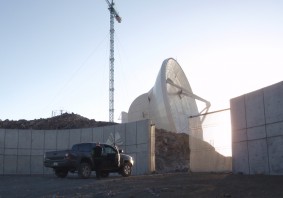
Sunset at the entrance of the LMT site.
The LMT meteorological station continuously monitors the local weather and atmospheric conditions at intervals of a few minutes. Measurements of temperature, pressure, humidity, wind-speed and direction, and atmospheric transmission (opacity) at 225 GHz are recorded. Volcán Sierra Negra is located in tropical latitudes, only 100km west of the Gulf of Mexico, and hence the LMT site experiences seasonal weather variations between the “wet” summer months (June – September) and the “dry” winter months (October – May).
The LMT project has compiled extensive data on the radiometric conditions at the site. Between 1997 and 2008, the measured 225 GHz (1.3 mm) atmospheric opacity demonstrates that the LMT site provides excellent millimeter wavelength transmission with a median opacity τ(225 GHz) < 0.12 (1st quartile τ < 0.07 in the dry winter months, see Fig. 1). Therefore, occasional 340 GHz (850μm) observations will also be possible during the best conditions in the winter period. During the summer months Volcán Sierra Negra remains an excellent 3 mm site. Opacity monitoring measurements at the LMT site have been reported in Ferrusca, D. and Contreras, J. (2014) and Zeballos, M. et al. (2016).

Fig.1 Atmospheric opacity measurements (at 225 GHz) and their variations during a whole year at the LMT site.
Generally the meteorological conditions (wind, temperature, precipitation) at the LMT site are relatively benign given the high altitude. For antenna performance, the most critical factor is the wind speed that distorts the surface of the dish and affects the antenna pointing. The median wind-speed is 6 m/s, and the median temperature is around 0° C with the diurnal variation of about 5° C. The LMT is designed to have a pointing accuracy of < 1 arcsecs in wind conditions < 10 m/s, which are recorded 90% of the time.